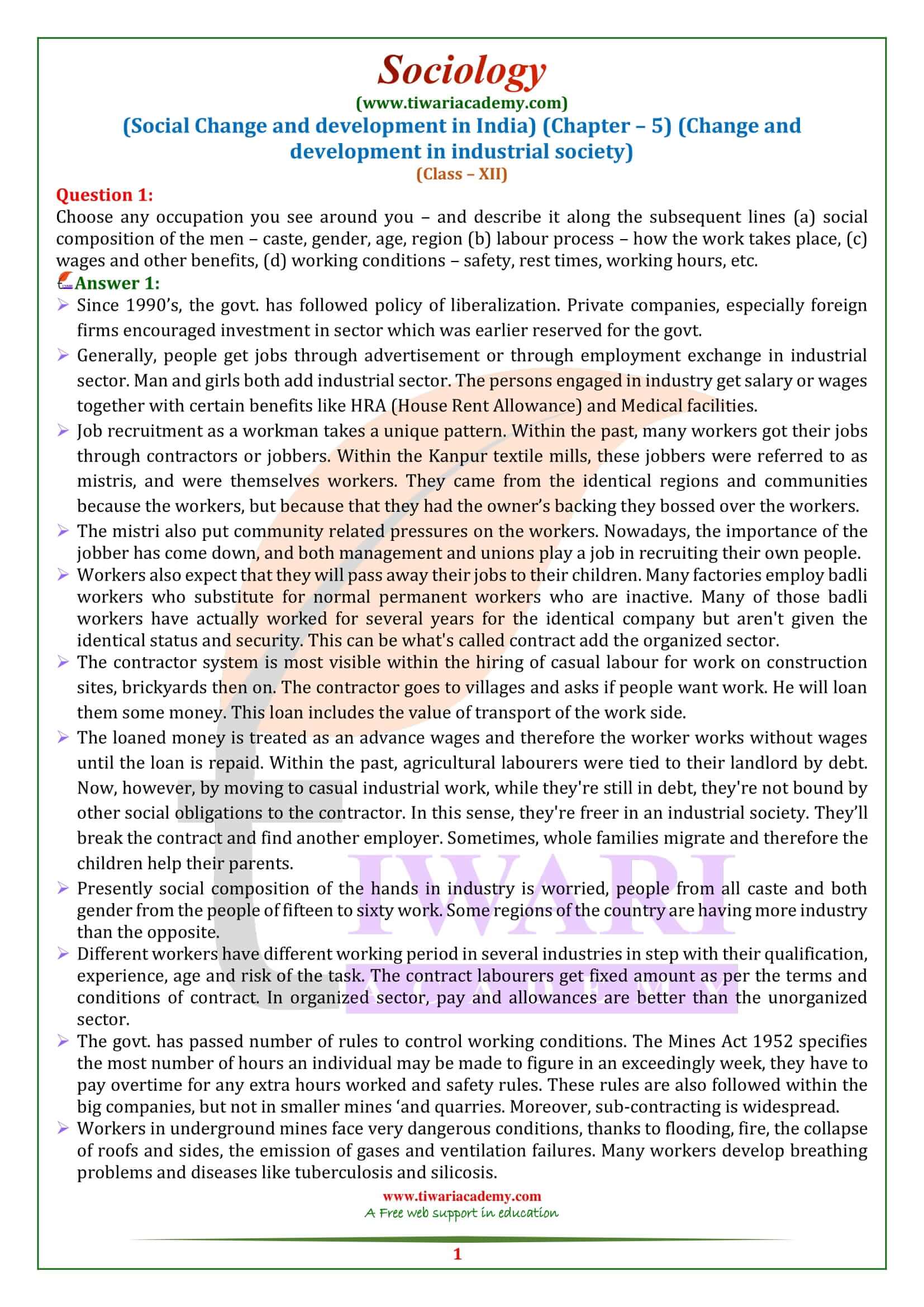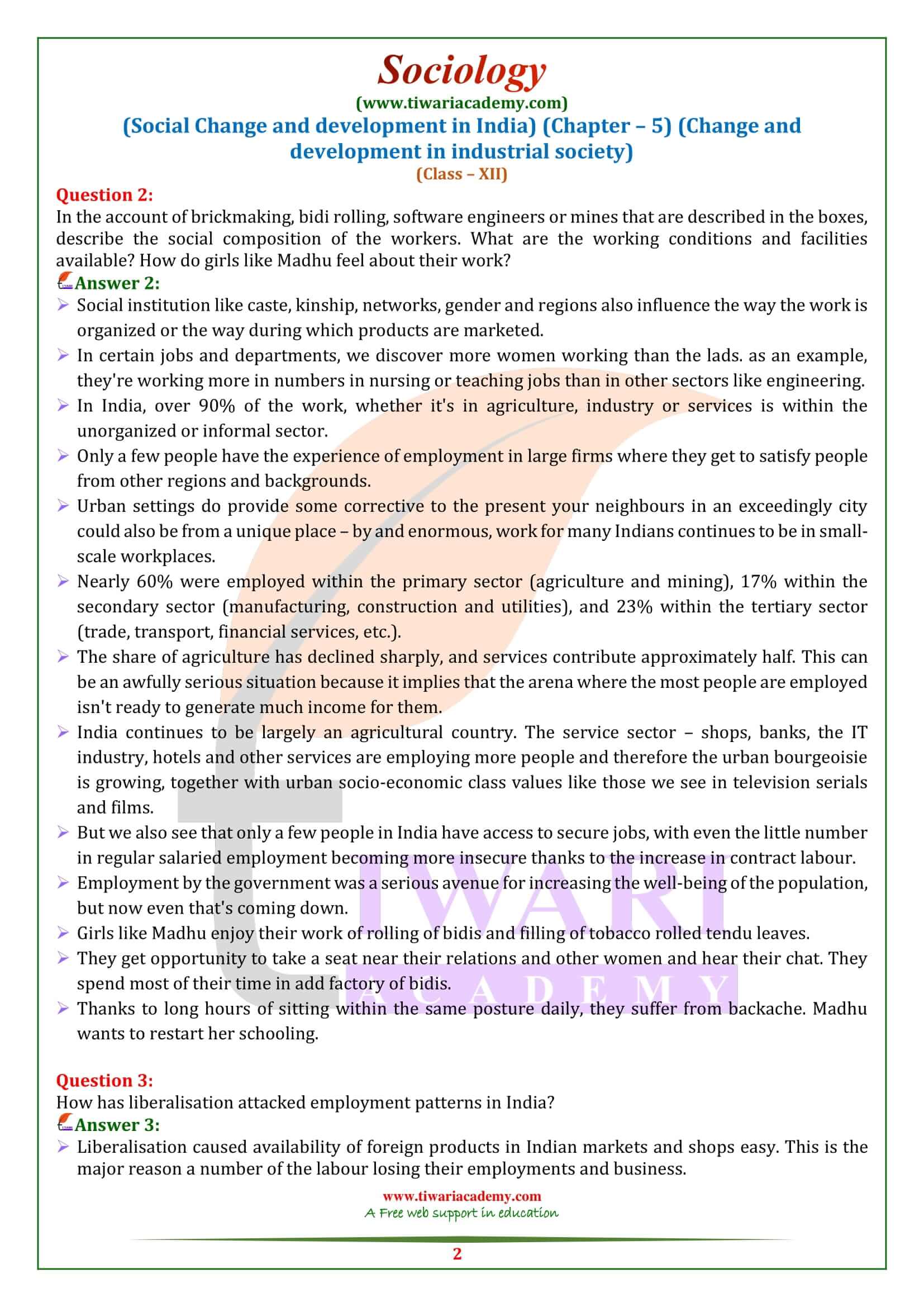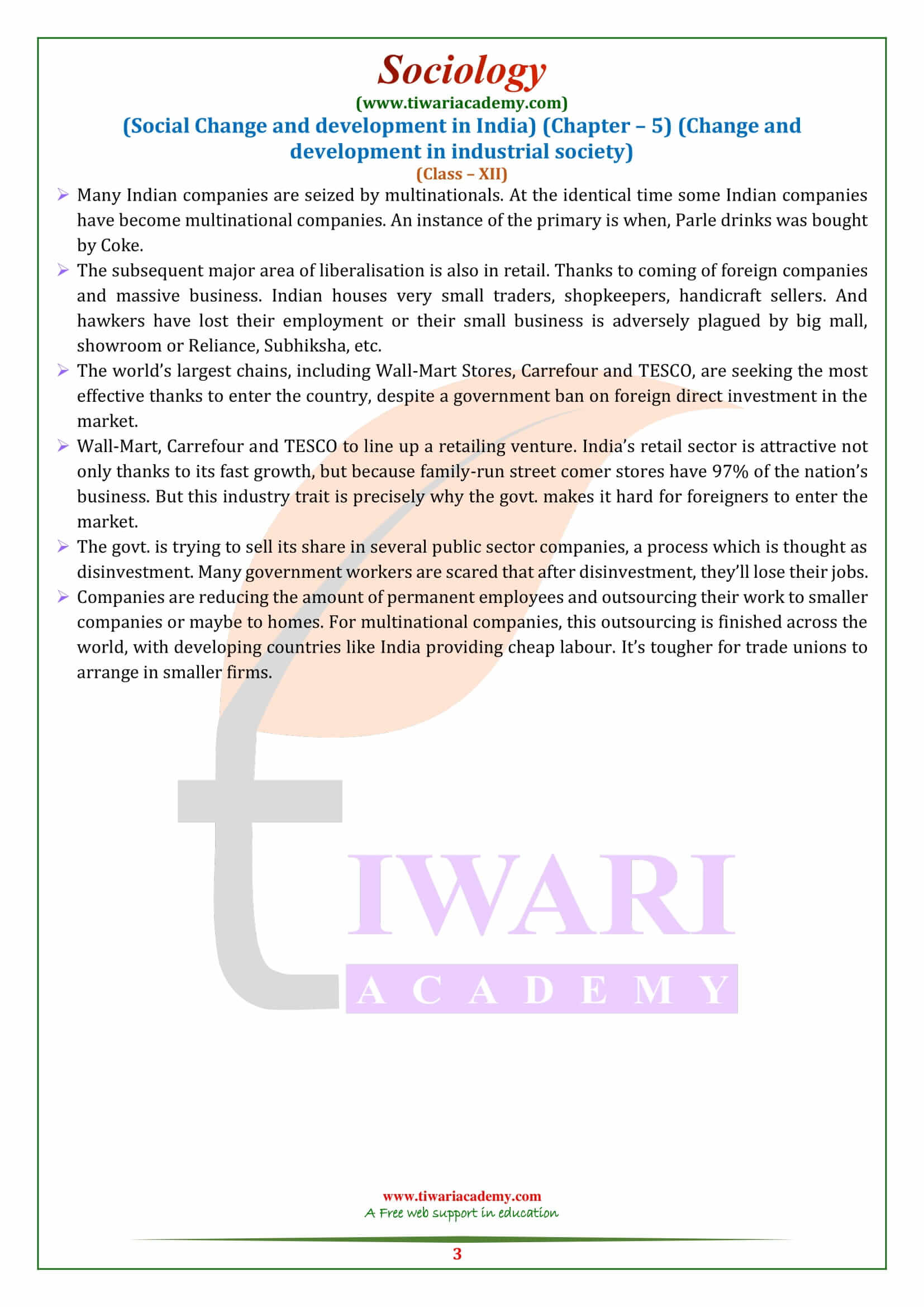NCERT Solutions for Class 12 Sociology Chapter 5 Change and Development in Industrial Society updated for new educational session 2025-26. Class 12 Sociology Part 2 Social Change and Development in India chapter 5 MCQ and important question answers are useful for both CBSE and state board students.
Class 12 Sociology Chapter 5 Change and Development in Industrial Society Question Answers
Choose any occupation you see around you – and describe it along the subsequent lines.
- (a) Social composition of the men – caste, gender, age, region
- (b) Labour process – how the work takes place,
- (c) Wages and other benefits,
- (d) Working conditions – safety, rest times, working hours, etc.
Since 1990’s, the govt. has followed policy of liberalization. Private companies, especially foreign firms encouraged investment in sector which was earlier reserved for the govt.
Generally, people get jobs through advertisement or through employment exchange in industrial sector. Man and girls both add industrial sector. The persons engaged in industry get salary or wages together with certain benefits like HRA (House Rent Allowance) and Medical facilities.
Job recruitment as a workman takes a unique pattern. Within the past, many workers got their jobs through contractors or jobbers. Within the Kanpur textile mills, these jobbers were referred to as mistris, and were themselves workers. They came from the identical regions and communities because the workers, but because that they had the owner’s backing they bossed over the workers.
The mistri also put community related pressures on the workers. Nowadays, the importance of the jobber has come down, and both management and unions play a job in recruiting their own people.
Workers also expect that they will pass away their jobs to their children. Many factories employ badli workers who substitute for normal permanent workers who are inactive. Many of those badli workers have actually worked for several years for the identical company but aren’t given the identical status and security. This can be what’s called contract add the organized sector.
The contractor system is most visible within the hiring of casual labour for work on construction sites, brickyards then on. The contractor goes to villages and asks if people want work. He will loan them some money. This loan includes the value of transport of the work side.
The loaned money is treated as an advance wages and therefore the worker works without wages until the loan is repaid. Within the past, agricultural labourers were tied to their landlord by debt. Now, however, by moving to casual industrial work, while they’re still in debt, they’re not bound by other social obligations to the contractor. In this sense, they’re freer in an industrial society. They’ll break the contract and find another employer. Sometimes, whole families migrate and therefore the children help their parents.
Presently social composition of the hands in industry is worried, people from all caste and both gender from the people of fifteen to sixty work. Some regions of the country are having more industry than the opposite.
Different workers have different working period in several industries in step with their qualification, experience, age and risk of the task. The contract labourers get fixed amount as per the terms and conditions of contract. In organized sector, pay and allowances are better than the unorganized sector.
The govt. has passed number of rules to control working conditions. The Mines Act 1952 specifies the most number of hours an individual may be made to figure in an exceedingly week, they have to pay overtime for any extra hours worked and safety rules. These rules are also followed within the big companies, but not in smaller mines and quarries. Moreover, sub-contracting is widespread.
Workers in underground mines face very dangerous conditions, thanks to flooding, fire, the collapse of roofs and sides, the emission of gases and ventilation failures. Many workers develop breathing problems and diseases like tuberculosis and silicosis.
In the account of brickmaking, bidi rolling, software engineers or mines that are described in the boxes, describe the social composition of the workers. What are the working conditions and facilities available? How do girls like Madhu feel about their work?
Social institution like caste, kinship, networks, gender and regions also influence the way the work is organized or the way during which products are marketed.
In certain jobs and departments, we discover more women working than the lads. as an example, they’re working more in numbers in nursing or teaching jobs than in other sectors like engineering.
In India, over 90% of the work, whether it’s in agriculture, industry or services is within the unorganized or informal sector.
Only a few people have the experience of employment in large firms where they get to satisfy people from other regions and backgrounds.
Urban settings do provide some corrective to the present your neighbours in an exceedingly city could also be from a unique place – by and enormous, work for many Indians continues to be in small-scale workplaces.
Nearly 60% were employed within the primary sector (agriculture and mining), 17% within the secondary sector (manufacturing, construction and utilities), and 23% within the tertiary sector (trade, transport, financial services, etc.).
The share of agriculture has declined sharply, and services contribute approximately half. This can be an awfully serious situation because it implies that the arena where the most people are employed isn’t ready to generate much income for them.
India continues to be largely an agricultural country. The service sector – shops, banks, the IT industry, hotels and other services are employing more people and therefore the urban bourgeoisie is growing, together with urban socio-economic class values like those we see in television serials and films.
But we also see that only a few people in India have access to secure jobs, with even the little number in regular salaried employment becoming more insecure thanks to the increase in contract labour.
Employment by the government was a serious avenue for increasing the well-being of the population, but now even that’s coming down.
Girls like Madhu enjoy their work of rolling of bidis and filling of tobacco rolled tendu leaves.
They get opportunity to take a seat near their relations and other women and hear their chat. They spend most of their time in add factory of bidis.
Thanks to long hours of sitting within the same posture daily, they suffer from backache. Madhu wants to restart her schooling.
How has liberalisation attacked employment patterns in India?
Liberalisation caused availability of foreign products in Indian markets and shops easy. This is the major reason a number of the labour losing their employments and business.
Many Indian companies are seized by multinationals. At the identical time some Indian companies have become multinational companies. An instance of the primary is when, Parle drinks was bought by Coke.
The subsequent major area of liberalisation is also in retail. Thanks to coming of foreign companies and massive business. Indian houses very small traders, shopkeepers, handicraft sellers. And hawkers have lost their employment or their small business is adversely plagued by big mall, showroom or Reliance, Subhiksha, etc.
The world’s largest chains, including Wall-Mart Stores, Carrefour and TESCO, are seeking the most effective thanks to enter the country, despite a government ban on foreign direct investment in the market.
Wall-Mart, Carrefour and TESCO to line up a retailing venture. India’s retail sector is attractive not only thanks to its fast growth, but because family-run street comer stores have 97% of the nation’s business. But this industry trait is precisely why the govt. makes it hard for foreigners to enter the market.
The govt. is trying to sell its share in several public sector companies, a process which is thought as disinvestment. Many government workers are scared that after disinvestment, they’ll lose their jobs.
Companies are reducing the amount of permanent employees and outsourcing their work to smaller companies or maybe to homes. For multinational companies, this outsourcing is finished across the world, with developing countries like India providing cheap labour. It’s tougher for trade unions to arrange in smaller firms.




